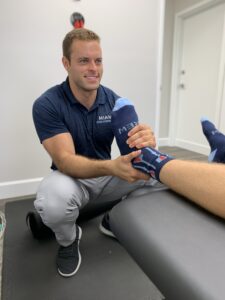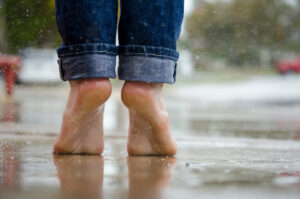Plantar Fasciitis
 Plantar fasciitis can be one of the most debilitating and frustrating orthopedic conditions due to the location and nature of the pathology.
Plantar fasciitis can be one of the most debilitating and frustrating orthopedic conditions due to the location and nature of the pathology.
Nearly 2 million Americans per year suffer from plantar fascial pain.
This pain can affect anyone but can be particularly bothersome to runners, athletes, and recreational fitness enthusiasts and keep them from engaging in the activities they love due to irritation to the plantar surface of the foot.
Unfortunately, in today’s medical model, most pain experienced at the bottom of the foot is labeled as plantar fasciitis, but in many cases, a different condition is causing the pain. Failure to identify the root cause of plantar pain leads to misdiagnosis.
As a result, patients are often treated with inappropriate therapies and are unable to find relief from their condition. The first step to resolving symptoms at the bottom of your foot is seeing a physician that will give you a thorough orthopedic, neurological, and functional movement examination.
Thanks to the beautiful weather in South Florida, running clubs throughout Hollywood, Hallandale, and Aventura train year-round, and need to stay ahead of this condition!
What is Plantar Fasciitis?
Plantar fasciitis is inflammation of a thick band of tissues connecting the heel to the ball of the foot called the plantar fascia. Symptoms generally include sharp or burning pain at the bottom of the foot when putting weight on the affected leg. Plantar fasciitis is not a condition that comes on acutely with trauma but instead develops over time due to poor biomechanics of the foot and ankle.
What causes Plantar Fasciitis?
The foot itself is made up of 26 bones, 33 joints, and over a hundred muscles, tendons, and ligaments. This creates the incredible potential for function and adaptation, but unfortunately, due to early integration of obstructive footwear and lack of attention to strengthening and mobilizing the foot/ankle complex, many individuals end up with poor foot mechanics leading to pain and conditions such as plantar fasciitis.
How do I know if I have Plantar Fasciitis?
The first step in knowing whether or not you have plantar fasciitis is seeing a movement-based physician such as the chiropractors at Miami Spine and Performance. Because plantar fasciitis is a multi-factorial condition, a thorough biomechanical exam, as well as palpation of joints and soft tissues in the area, should be expected on the first visit.
Decrease pain associated with Plantar Fasciitis
Modalities such as ice and ultrasound are often utilized to decrease pain and may potentially reduce the inflammation but without changing the biomechanics of the lower extremity, recurrence of symptoms is very likely.
Other conditions that cause foot pain
There are also several other conditions that can produce pain at the bottom of the foot that are not plantar fasciitis.
A dysfunction in the lower back, for example, can put pressure on the sciatic nerve, which can lead to irritation in the tibial nerve and the branches of the plantar nerves at the bottom of the foot.
The first step in evaluating any lower extremity condition should be ruling out the involvement of the lower back and nerves as the source of pain by a clinician utilizing the Mckenzie Method of Mechanical Diagnosis and Therapy (MDT).
Pain associated with Plantar Fasciitis
If the lower back has been ruled out as the source of pain, true plantar fasciitis will present with:
- Heel Pain or Pain in the medial arch of the foot first thing in the morning
- Pain with weight-bearing, running or playing sports
- Bone Spur formation on the heel of the foot.
What can predispose an individual to Plantar Fasciitis?
There are several structural and biomechanical factors that can predispose an individual to plantar fasciitis including:
- Tightness in the calf muscles (gastrocnemius and soleus)
- Limited Ankle Dorsiflexion
- Poor joint biomechanics in the foot
- Inefficient Windlass Mechanism
- Overpronation (flat foot, poor stability)
- Underpronation (Rigid foot, limited shock absorption)
- Overtraining (particularly long-distance running) or not easing into a new training regiment properly
- Improper footwear
- Obesity
- Standing on hard surfaces for too long
- Improper motion of the hamstrings and hips
How can chiropractic care help your Plantar Fasciitis?
Because excessive muscle tightness in the calf muscles predispose an individual to poor running technique, a chiropractic physician trained Active Release Technique will be able to work through stiffness in the gastroc-soleus complex and ensure proper sliding of tissues to prevent muscle tightness.
 Chiropractic Manipulation Techniques
Chiropractic Manipulation Techniques
Poor motion of the foot and ankle are generally due to what is termed a “joint fixation.” Chiropractic physicians are trained extensively in manipulation techniques for the joints of the foot and ankle to ensure proper motion throughout the area. Working with a movement-based chiropractor will also provide you are given specific drills to perform at home to keep your foot and ankle moving optimally between your chiropractic visits.
Foot rehabilitation exercises
Contrary to popular belief, a flat or rigid foot can be trained to move better. There are several specific exercises that a rehab focused clinician can prescribe to strengthen your arch, stabilize your foot, or improve mobility and shock absorption, depending on the findings of your physical exam.
Movement biomechanics
Because the entire lower extremity is connected (foot, ankle, knee, hip, pelvis), poor movement patterns anywhere along this chain can result in symptoms downstream in the foot. A sports chiropractic physician is trained to examine the movement biomechanics of the lower extremity and correct faults even in areas where you are not experiencing symptoms.
Sports performance chiropractic care
Seeing a chiropractic physician that has a background in sports performance and is a Certified Strength and Conditioning Coach (CSCS), such as the physicians at Miami Spine and Performance, can assist in properly periodizing your training and footwear choices to make sure that you meet your performance goals outside of the clinic and remain pain-free.
Getting to the root of foot and ankle pain
Foot and ankle pain can be very frustrating and debilitating, particularly if you are an avid runner, triathlete, Crossfitter or recreational fitness athlete.
If you are currently training regularly, but not experiencing any symptoms, it is advisable to get a thorough functional assessment from a movement-focused clinician that can inform you about any biomechanical faults you may have and can correct them before you experience any symptoms that can affect your training.
If you are currently experiencing foot/ankle pain or plantar fasciitis and are looking for a doctor that will look at the condition holistically, address all the appropriate variables and get you back to what you love as quickly as possible, please give us a call or schedule online.


